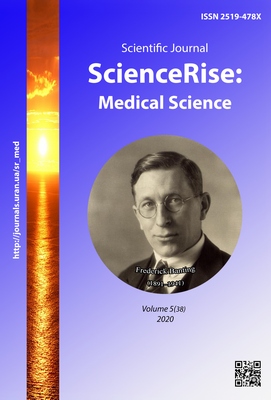Modern possibilities of diagnosis of cell’s membrane-receptor complex dysfunction in the acute period of ischemic stroke
DOI:
https://doi.org/10.15587/2519-4798.2020.212710Keywords:
complex, receptor, adrenal reactivity, membrane, ischemia, moleculeAbstract
During the development of the acute phase of ischemic stroke (IS), the cytoplasmic membranes of cells and receptor complex are primarily damaged. Structural changes in brain tissue are accompanied by violations of its electric physical characteristics, which are quite qualitatively possible to record using microwave dielectrometry.
The aim of the study was to learn the features of changes in the dielectric properties of peripheral blood erythrocytes of patients with IS during in vitro exposure to adrenergic drugs depending on the severity of the disease to optimize diagnosis.
Material and methods of research. Measurements of complex dielectric constant (CDC) were performed by EHF dielectrometry at a fixed frequency of 39.5 × 109 Hz, which is in the region of γ-dispersion. The work was based on the materials of a comprehensive examination of 350 patients with the first in the life of IS on the 1st, 10th and 21st day of the disease.
The severity of the condition and the degree of neurological deficit were determined using the stroke scale of the US National Institutes of Health (NIHSS) in the first hours of the disease, in the dynamics of treatment on the 10th and 21st day. There were 2 clinical groups: 1st (n = 183) – patients in a state of moderate severity (mean score on the NIHSS scale 11.74±0.33); 2nd (n = 167) – patients with severe IS (average score on the NIHSS scale 24.06±0.29).
Results. In the control group, there was a significant decrease after exposure to adrenaline solution. The reaction to adrenaline in patients with IS was almost absent. It indicates a decreasing of erythrocytes β-adrenoceptors (β-ARs) sensitivity to stimulants due to their desensitisation. In patients with moderate severity, erythrocytes are more reactive than in patients with more severe IS.
Conclusions. The deviation of CDC of erythrocytes induced by adrenergic drugs in vitro is a manifestation of a specific response of cells to biologically active substances and depends on the functional state of the sympathoadrenal system
References
- Britnell, S. R., Chillari, K. A., Brown, J. N. (2018). The Role of Xanthine Oxidase Inhibitors in Patients with History of Stroke: A Systematic Review. Current Vascular Pharmacology, 16 (6), 583–588. doi: http://doi.org/10.2174/1570161115666170919183657
- Khoshnam, S. E., Winlow, W., Farzaneh, M., Farbood, Y., Moghaddam, H. F. (2017). Pathogenic mechanisms following ischemic stroke. Neurological Sciences, 38 (7), 1167–1186. doi: http://doi.org/10.1007/s10072-017-2938-1
- Arkhypova, K., Volokh, F., Nosatov, A., Malakhov, V. (2015). Diagnostic potential of microwave techniques in neurology: new insight into beta-adrenergic activity testing. European Journal of Neurology, 22, 591.
- Arkhypova, K., Nosatov, A., Krasov, P., Fisun, A., Nurushev, M., Malakhov, V. (2015). Dual-Purpose Microwaves Application: Blood Sensing and Self-Blood Treatment. European Microwave Conference. Paris, 817–820. doi: http://doi.org/10.1109/eumc.2015.7345889
- Gapeyev, A. B., Sokolov, P. A., Chemeris, N. K. (2001). Response of membrane-associated calcium signaling systems of the cell to extremely low-frequency external signals with different waveform parameters. Electro- and Magnetobiology, 20 (1), 107–122. doi: http://doi.org/10.1081/jbc-100103163
- Sardini, A., Amey, J. S., Weylandt, K.-H., Nobles, M., Valverde, M. A., Higgins, C. F. (2003). Cell volume regulation and swelling-activated chloride channels. Biochimica et Biophysica Acta (BBA) - Biomembranes, 1618 (2), 153–162. doi: http://doi.org/10.1016/j.bbamem.2003.10.008
- Horga, J. F., Gisbert, J., De Agustı́n, J. C., Hernández, M., Zapater, P. (2000). A Beta-2-Adrenergic Receptor Activates Adenylate Cyclase in Human Erythrocyte Membranes at Physiological Calcium Plasma Concentrations. Blood Cells, Molecules, and Diseases, 26 (3), 223–228. doi: http://doi.org/10.1006/bcmd.2000.0299
- Johnson, J. A., Terra, S. G. (2002). Вeta-adrenergic receptor polymorphisms: Cardiovascular disease associations and pharmacogenetics. Pharmaceutical Research, 19 (12), 1779–1787. doi: http://doi.org/10.1023/a:1021477021102
- Du, Y., Wang, W., Lutton, A. D., Kiyoshi, C. M., Ma, B., Taylor, A. T. et. al. (2018). Dissipation of transmembrane potassium gradient is the main cause of cerebral ischemia-induced depolarization in astrocytes and neurons. Experimental Neurology, 303, 1–11. doi: http://doi.org/10.1016/j.expneurol.2018.01.019
- Webster, J. C., Cidlowski, J. A. (2006). Downregulation of the Glucocorticoid Receptor. A Mechanism for Physiological Adaptation to Hormonesa. Annals of the New York Academy of Sciences, 746 (1), 216–220. doi: http://doi.org/10.1111/j.1749-6632.1994.tb39238.x
- Ishiguro, Y., Morgan, J. P. (2001). Effect of endogenous catecholamine on myocardial stunning in a simulated ischemia model. Fundamental & Clinical Pharmacology, 15 (2), 111–116. doi: http://doi.org/10.1046/j.1472-8206.2001.00015.x
- Meilhac, O. (2015). High-Density Lipoproteins in Stroke. High Density Lipoproteins: from Biological Understanding to Clinical Exploitation, 509–526. doi: http://doi.org/10.1007/978-3-319-09665-0_16
- Liu, L., Yuan, H., Denton, K., Li, X., McCullough, L., Li, J. (2016). Calcium/calmodulin-dependent protein kinase kinase β is neuroprotective in stroke in aged mice. European Journal of Neuroscience, 44 (4), 2139–2146. doi: http://doi.org/10.1111/ejn.13299
Downloads
Published
How to Cite
Issue
Section
License
Copyright (c) 2020 Володимир Личко

This work is licensed under a Creative Commons Attribution 4.0 International License.
Our journal abides by the Creative Commons CC BY copyright rights and permissions for open access journals.
Authors, who are published in this journal, agree to the following conditions:
1. The authors reserve the right to authorship of the work and pass the first publication right of this work to the journal under the terms of a Creative Commons CC BY, which allows others to freely distribute the published research with the obligatory reference to the authors of the original work and the first publication of the work in this journal.
2. The authors have the right to conclude separate supplement agreements that relate to non-exclusive work distribution in the form in which it has been published by the journal (for example, to upload the work to the online storage of the journal or publish it as part of a monograph), provided that the reference to the first publication of the work in this journal is included.









